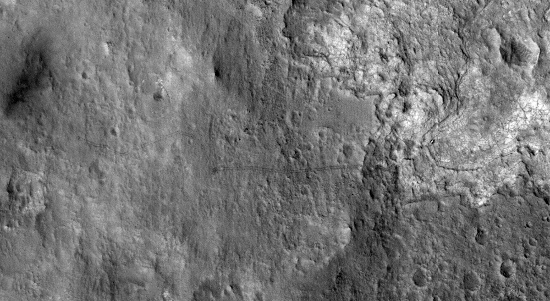Curiosity traces from space
(Exploration of the Mars exploration robot named Curiosity (Curiosity rover) of NASA's US Aerospace Agency can be seen through a new image taken by a spacecraft. unmanned.
The photo was taken using a HiRise camera mounted on NASA's Unmanned Mars (MRO) probe spacecraft. The photo shows where Curiosity has gone since landing on Mars's Gale crater in August 2012.
The place where the Curiosity landed, known as ' Bradbury landing ' - named after the science fiction writer Ray Bradbury, appears to be a dark mark on the left side of the picture - the trace left by the motorized crane. Missile to help Curiosity land on Mars's surface.

Where the ship Curiosity landed is seen from space
The photo shows Curiosity's twisty road compared to its current location, a low-lying area called Yellowknife Bay (Yellowknife Bay). The six-wheeled robot has moved 2,300 feet (700 meters) and is currently seen as a bright bead on the right side of the image, the scientists said.
Curiosity's mission is to determine whether the Gale crater area is once suitable for microbial life. It has 17 cameras and 10 different scientific devices to support this task.
The robot has moved through a river where once the deep water flows to the ankle through the past and has discovered many signs of water that once existed in Yellowknife Bay.
The team is preparing for the first use of Curiosity's drill head. In the next two weeks or so, the group plans to drill into an open rock called 'John Klein' in Yellowknife Bay. Curiosity's drill head allows scientists to drill up to 1 inch (2.5 cm) into the rock, deeper than the drill of any previous self-propelled Mars probe.
While Curiosity has discovered many areas close to the landing site, its final destination is Mount Sharp's mountain, a mysterious mountain of 5.5 km in the middle of the Gale crater.
Mount Sharp's layers record changes in the environment over time, scientists hope to discover this when Curiosity reaches the foot of the mountain.
Scientists say Curiosity will reach the foot of Mount Sharp, which is located about 6 miles (10km), after completing the rock drilling task in Yellowknife Bay.
- NASA found signs of life on Mars
- Curiosity robot moves by itself
- Found traces of plankton in the universe
- The Curiosity ship drills a second nose on Mars
- Robots on Mars paralyzed because of computer problems
- Curiosity will explore Sharp Mountain on Mars
- Upgrade the Curiosity self-propelled device
- The Curiosity is about to sample the first stone on Mars
- More than 6.5 operations on Mars, NASA has come up with a new way to take advantage of the Curiosity robot
- NASA robots search for 'treasure' on Mars
- NASA reveals driver 'monster car on Mars'
- Mars probe robots can fire lasers themselves
 Van Allen's belt and evidence that the Apollo 11 mission to the Moon was myth
Van Allen's belt and evidence that the Apollo 11 mission to the Moon was myth The levels of civilization in the universe (Kardashev scale)
The levels of civilization in the universe (Kardashev scale) Today Mars, the sun and the Earth are aligned
Today Mars, the sun and the Earth are aligned The Amazon owner announced a secret plan to build a space base for thousands of people
The Amazon owner announced a secret plan to build a space base for thousands of people